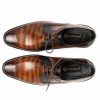In the world of handmade leather shoes, where craftsmanship defines quality, hand welting stands as one of the most revered—and rare—construction methods. It’s a time-intensive, skill-demanding technique that separates fast fashion from timeless durability. While machine-made shoes dominate most of the market, true enthusiasts and artisan brands like Handsole continue to uphold this centuries-old tradition.
In this article, we’ll explore what hand welting is, why it matters, how it compares to Goodyear welting, and what makes it the gold standard in bespoke shoemaking.
What Is Hand Welting?
Hand welting is the traditional shoemaking method where the leather upper is manually stitched to the insole and a welt—a leather strip that runs around the shoe’s perimeter—entirely by hand using an awl and waxed thread. No machines are involved. The outsole is then stitched to the welt, creating a durable and resoleable foundation.
This process is typically done on a hand-lasted shoe, meaning the upper is also shaped over the last by hand before welting begins. The result is a shoe that is not only structurally strong but also shaped with precise fit and detailing.
Why Does Hand Welting Matter?
Unlike faster, industrial techniques, hand welting delivers:
Superior Durability: The hand-sewn stitch creates a more flexible and lasting bond than machine-welted alternatives.
Easy Resoling: You can replace the outsole multiple times without compromising the integrity of the upper or insole.
Water Resistance: The tight, hand-pulled stitch naturally helps seal out moisture.
True Craftsmanship: Each pair is unique and carries the marks of its maker—no shortcuts, just skill.
Step-by-Step: How Hand Welting Is Done
Here’s a simplified look at what goes into this complex process:
Hand Lasting: The leather upper is pulled over the last and tacked into place.
Channel Cutting: A flap is cut into the insole to create a holdfast (a channel where stitching will go).
Welt Attachment: The welt is stitched to both the upper and insole using a curved needle and waxed thread.
Sole Stitching: The outsole is stitched to the welt, completing the layered construction.
Finishing: Edges are trimmed, soles are shaped and burnished, and the shoe is polished by hand.
Each step requires precision and patience. It can take 10–12 hours per pair just for the construction phase.
Hand Welting vs. Goodyear Welting
While both methods are welted constructions and resoleable, there are key differences:
| Feature | Hand Welting | Goodyear Welting |
|---|---|---|
| Construction Method | Fully done by hand | Partly machine-stitched |
| Insole Channel | Cut by hand to create holdfast | Machine-attached canvas rib |
| Durability | Higher (no canvas to degrade over time) | Durable, but canvas rib may wear down |
| Flexibility | More flexible and form-fitting | Often stiffer due to cork filling |
| Craftsmanship Appeal | Artisanal, unique, labor-intensive | Industrialized, more uniform |
Who Should Choose Hand-Welted Shoes?
Collectors & Connoisseurs: For those who value true artisanal detail and traditional construction.
Luxury Buyers: Hand-welted shoes are rare and signify high-end craftsmanship.
Frequent Wearers: If you want a shoe that can be resoled for life, this is your best bet.
Ethical Consumers: Hand-welted construction often indicates small-batch production, ethical labor, and sustainable sourcing.
How Handsole Uses Hand Welting
At Handsole, we hand welt each pair using full-grain cow crust leather, vegetable-tanned midsoles, and hand-waxed thread. Our artisans train for years to master this construction. From last shaping to final polish, every pair reflects over 100 touchpoints of handwork.
We believe shoes should age with character—not fall apart. That’s why we’ve invested in reviving old-world techniques like hand welting for today’s modern wardrobes.
Care Tips for Hand-Welted Shoes
To preserve your investment:
Brush regularly with a horsehair brush
Use cedar shoe trees to absorb moisture
Apply leather conditioner every few months
Rotate pairs to allow leather to rest
Resole when needed by a skilled cobbler (or send back to Handsole)
Final Thoughts: Is Hand Welting Worth It?
Absolutely. While hand-welted shoes may take longer to produce and come at a premium price, they are built to last—and built with meaning. Every stitch is a testament to craftsmanship, every curve shaped by the hands of a skilled artisan.
For anyone serious about quality footwear, hand welting isn’t just a construction method—it’s a philosophy.












